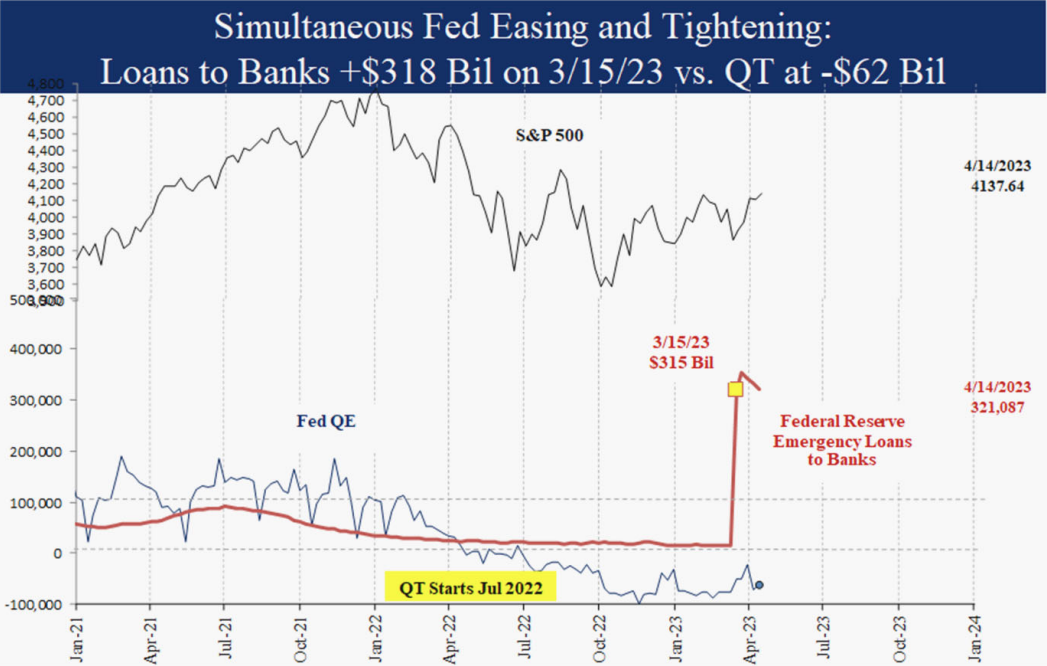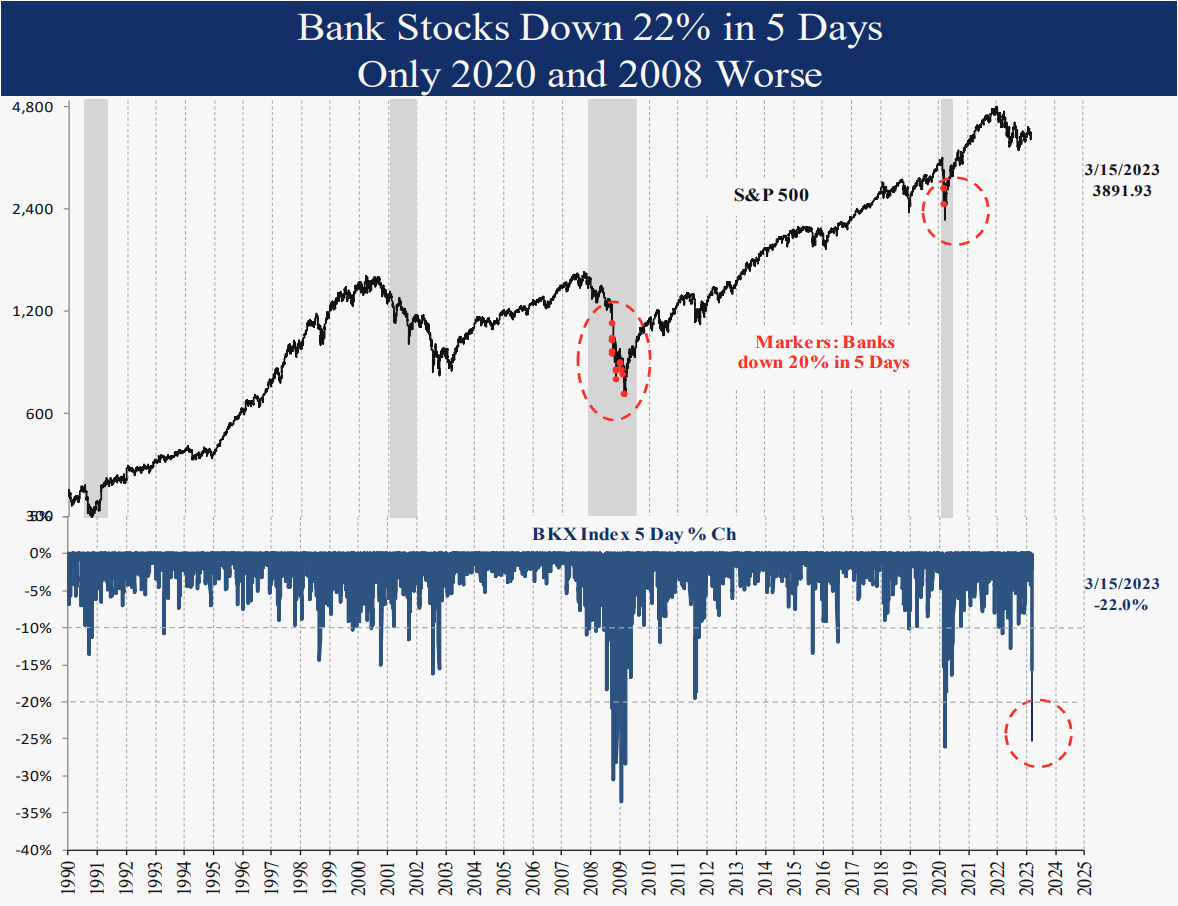Banking Panic to Default Risk and Beyond
Investing Environment Review and Outlook – Volume 71
Banking Panic to Default Risk and Beyond
Last month we discussed the Fed response to the March banking panic and the implications of the weak dollar. Since then, as it became clear the banking system had stabilized, the media was quick to shift to a potential U.S. debt default as their next disaster story. The recession drumbeat is louder than ever, and as a result most investor groups remain under invested despite a 7‐month equity rally from the October low. Conditions we monitor like the weak economy, mixed monetary policy, falling inflation, low investor positioning and strong tape indicators as a group are positive for equities historically despite the possibility of a recession ahead. Recessions are great for historians, but mostly useless for investors since they are somewhat arbitrary and only defined after the fact. This month we discuss the event risk posed by the debt ceiling debate, and the more serious issue behind it, strength in China lending and presidential cycle seasonality. U.S., Foreign‐Developed, and Emerging Markets equities remain bullish 5 ratings. Long‐term bonds remain a neutral 3 rating. Gold remains a bullish 5 rating and Industrial Commodities remain a neutral 3 rating.
Debt Ceiling Debate Event Risk
Market consensus has focused primarily on the 18% S&P 500 decline during one prior debt ceiling debate in 2011, illustrating their tendency toward “if it bleeds it leads.” Coverage usually omits the two other recent debt ceiling debates in 2013 and 2017 which ended without incident for the equity market. One reason equities are at less downside risk today is investor positioning is a mirror image from 2011 when investors started the year fully invested. This year investors were extremely pessimistic and underinvested, with significant cash available to support stock prices. Despite the YTD rally investors remain cautious. A Federal debt default would certainly cause significant short‐term disruption, but the more serious issue for forward looking markets is the sustainability of Federal spending levels.
For perspective, the debt limit itself was enacted over 100 years ago in 1917 when federal debt was just $5.7 billion at 10% of GDP. It rose to 30% of GDP during WW I. During WW II, the debt rose to a record 110% of GDP before strong post war growth, followed by inflation in the 1970’s caused a decline in federal debt to just 30% of GDP by 1980. Since then, federal deficit spending resulted in a new record high of 120% debt to GDP today. That’s equivalent to $92,000 per capita up from just $4,000 per capita in 1980.
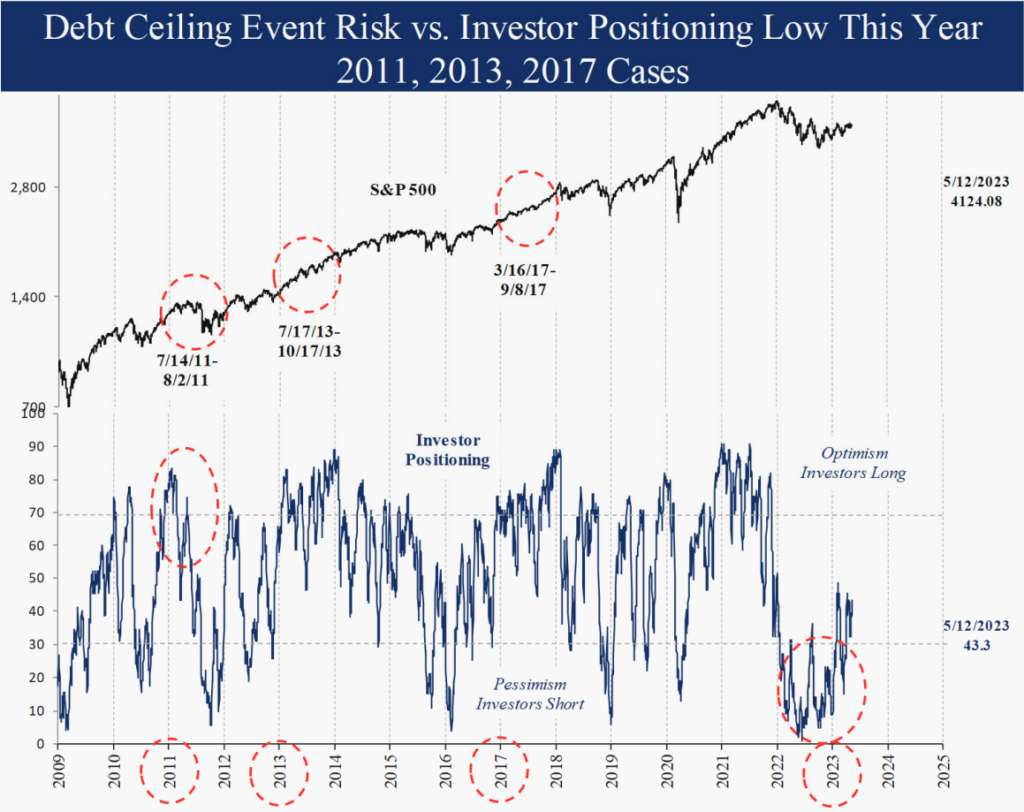
Deficit spending and rising debt like we’ve seen since 1980 is stimulative since it is essentially pulling consumption forward in time. In the 1960’s a 3% deficit was considered large. In the last 20 years deficit spending has been a bad habit without consequences. Today we’re running an 8% deficit even without a recession. When the debt cycle turns there are major tail risks like persistent inflation, a weaker dollar and higher interest rates. Fiscal austerity may be forced by the market.
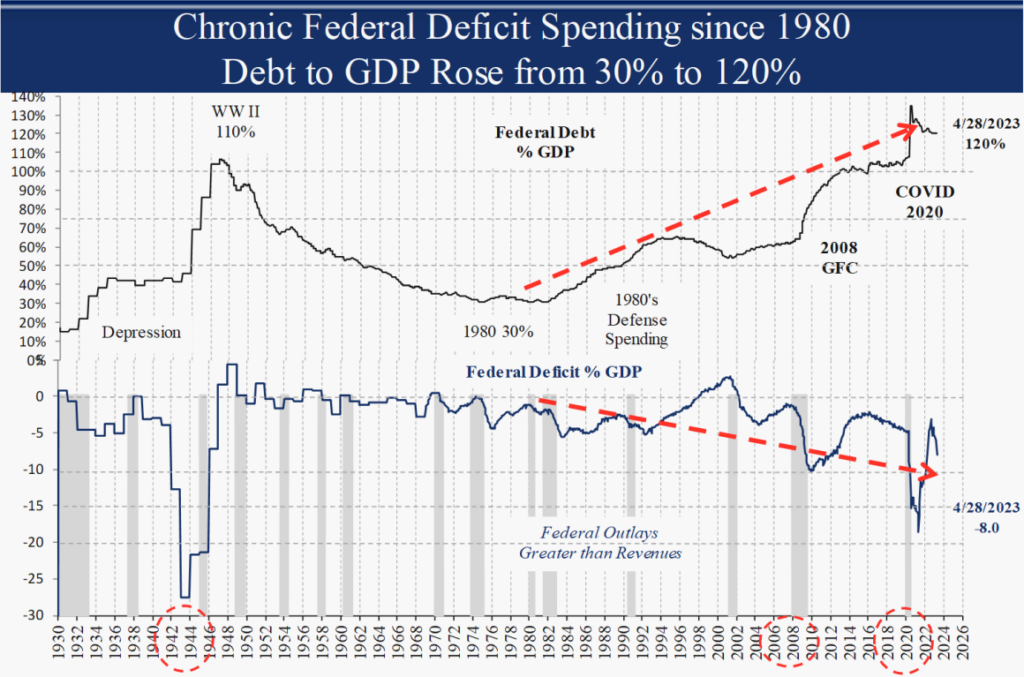
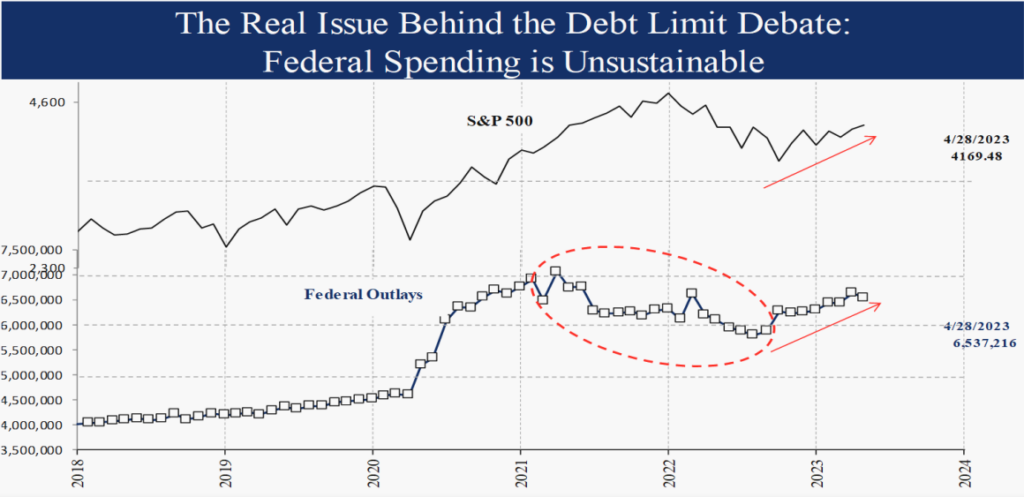
Banking Panic Stabilized
The banking panic started on March 10th when the SVB failure caused two weeks of extreme deposit outflows which have since stabilized. Loans, which declined initially in the first two weeks have also stabilized, while banks stocks were up 7% on 5/17/23. It appears fears over a mass deposit run were overblown, but we will continue to watch for further deterioration.
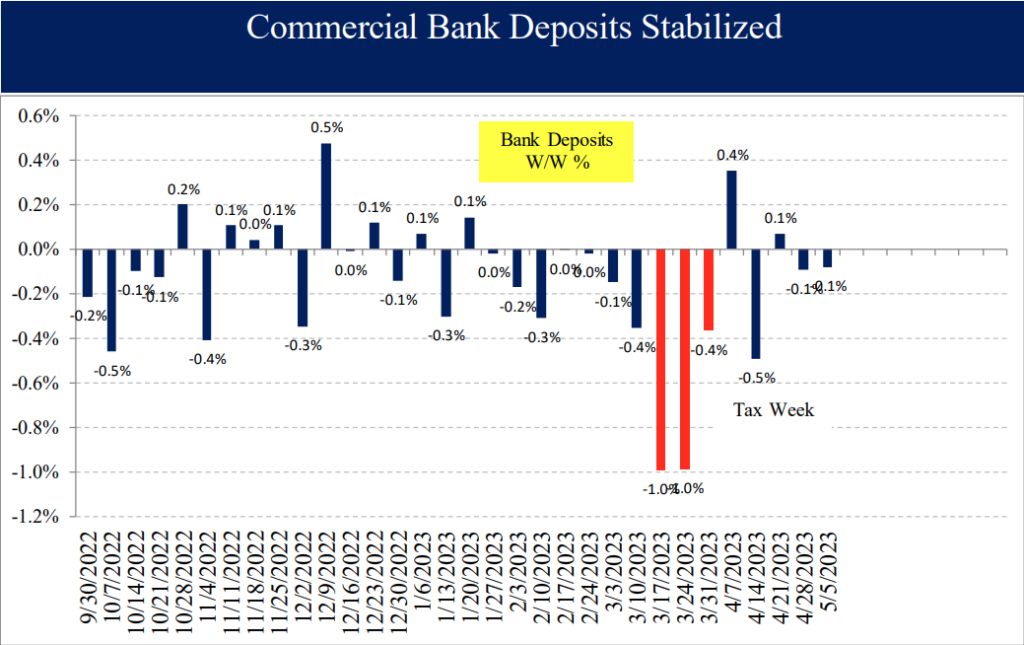
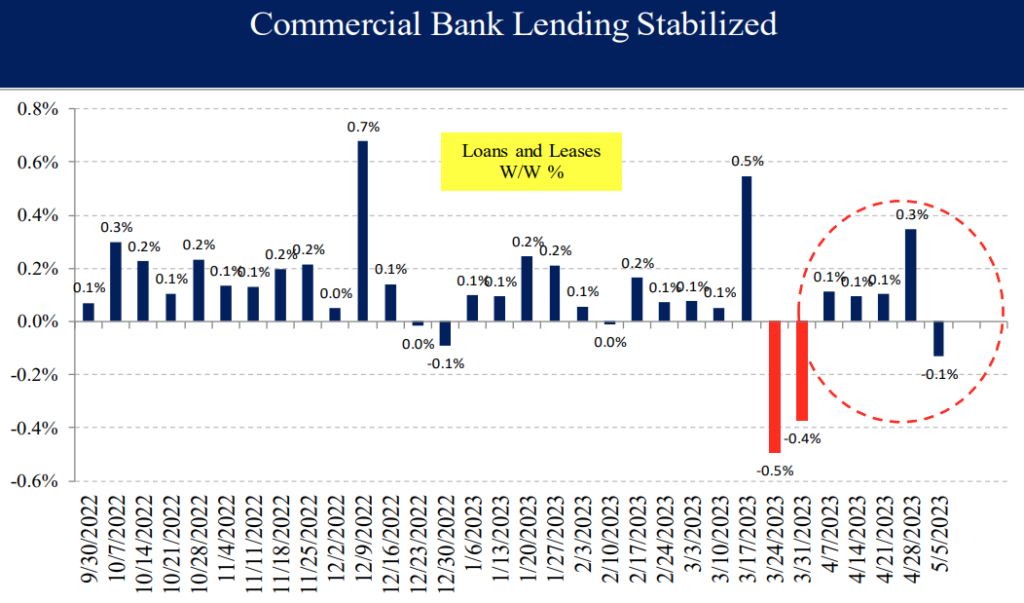
Presidential Cycle Positive Seasonality Ending
2023 is the third year of the presidential cycle. Historically the best three quarters of the four‐year cycle were Q4 in year 2 and Q1 and Q2 of year 3. This means the positive seasonality ends at the end of Q2 just a month away. At that point depending on conditions at the time we will determine whether seasonality is significant either way.
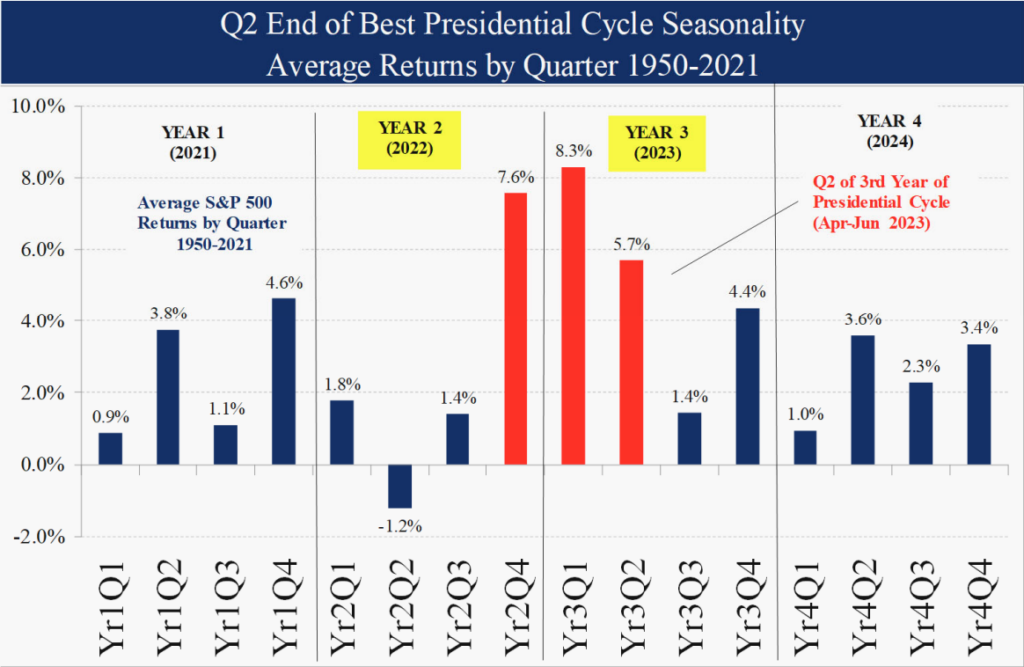
China Lending Up: Bullish for Economy
The China reopening story was supported by the data in Q1, but has since faded as economic releases showed slower growth. Perhaps in response, China bank lending, directed by the PBoC, has exploded by 44% Y/Y in the last 3 months. Prior cases were bullish for the Chinese economy, and may be one reason we could avoid a global recession.
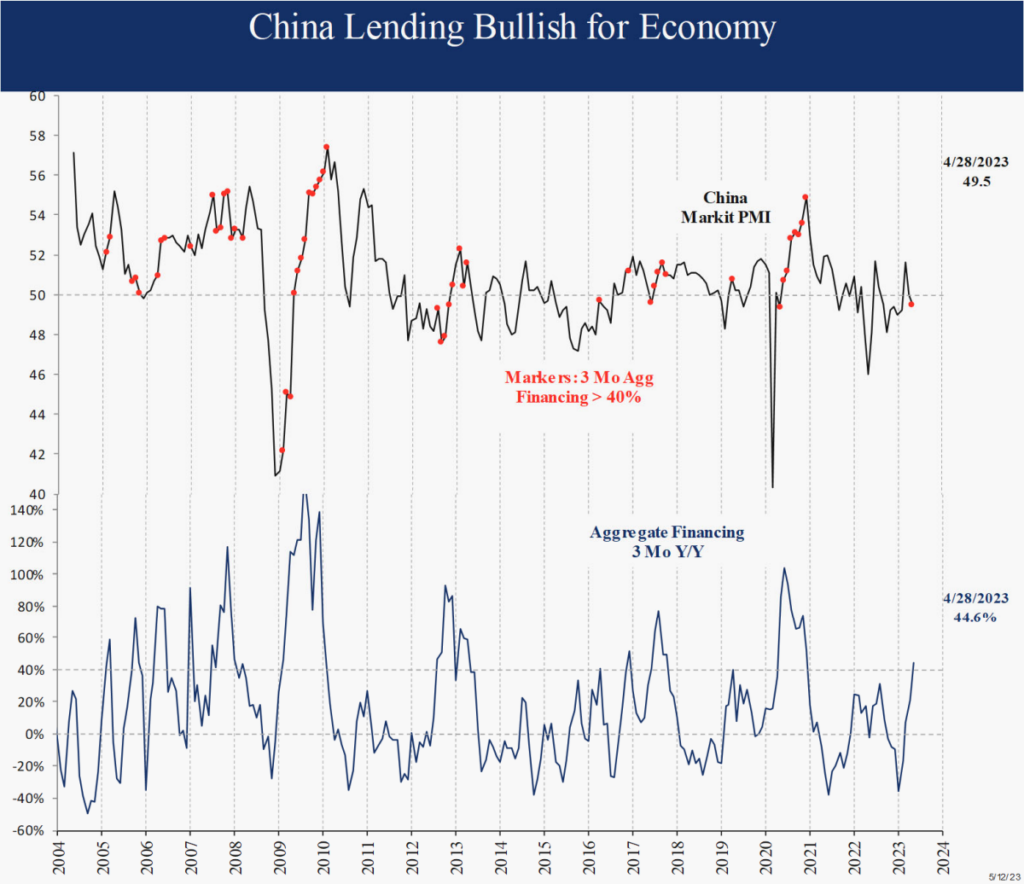
Lower Inflation Ahead
Besides the recession drumbeat, there has also been a parade of Fed governors insisting their job is not done with more hikes to come. What they may not be considering is the year ago CPI numbers were extreme in May and June, averaging 1.0% M/M. What that means is if the M/M in May and June this year average 0.3% as is likely based on recent releases, then the CPI headline Y/Y would be 3.4% by June. And that would certainly give the Fed cover to pause hiking. Our inflation outlook indicators remain neutral as well.
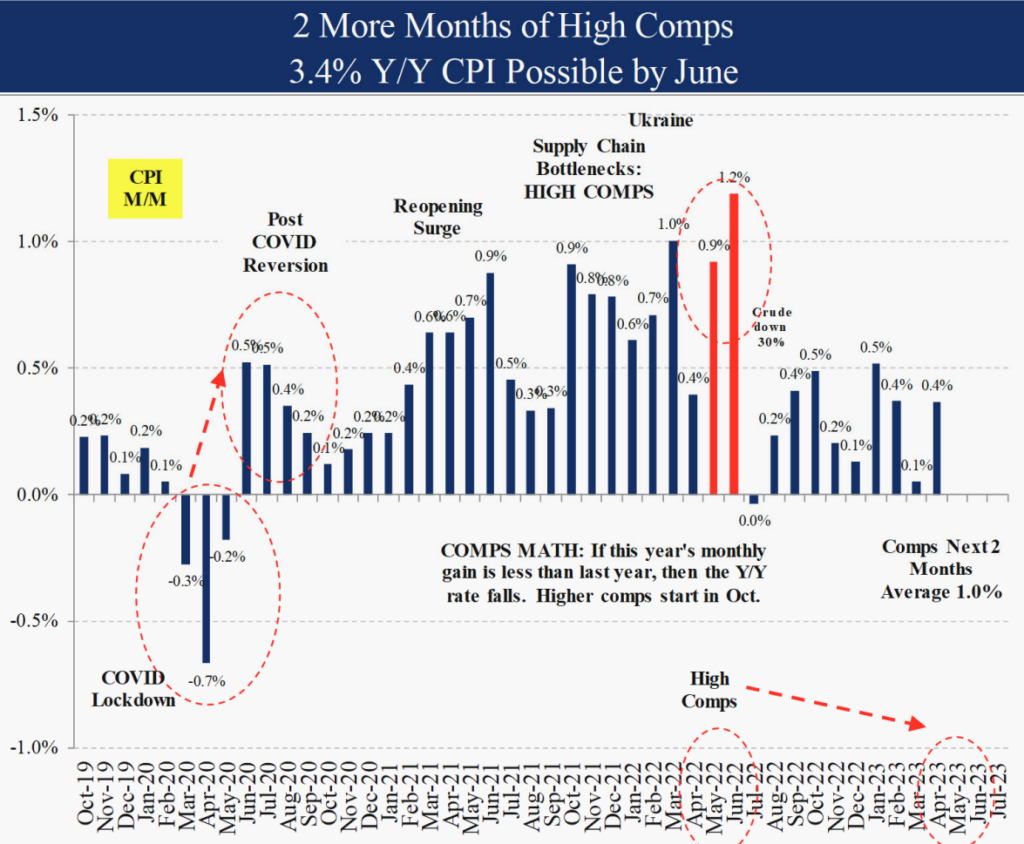
Summary
This month we discussed the stabilization of the banking crisis and the longer‐term implications of the debt ceiling debate beyond a potential technical default. The debt fueled deficit spending is certainly unsustainable and means bigger long‐term risks like sustained inflation and a weaker dollar are significant. However, for now conditions for equities are positive despite the media focus on recession. We will continue to watch our indicators on a daily basis for changes. Thank you for your support and please contact us with any questions.
IMPORTANT DISCLOSURES
This review and outlook report (this “Report”) is for informational, illustration and discussion purposes only and is not intended to be, nor should it be construed as, financial, legal, tax or investment advice, of Brenton Point Wealth Advisors LLC or any of its affiliates (“Brenton Point”). This Report does not take into account the investment objectives, financial situation, restrictions, particular needs or financial, legal or tax situation of any particular person and should not be viewed as addressing any recipient’s particular investment needs. Recipients should consider the information contained in this Report as only a single factor in making an investment decision and should not rely solely on investment recommendations contained herein, if any, as a substitution for the exercise of independent judgment of the merits and risks of investments.
This material is based upon information obtained from various sources that Brenton Point believes to be reliable, but Brenton Point makes no representation or warranty with respect to the accuracy or completeness of such information. Views expressed herein are current only as of the date indicated and are subject to change without notice.
This Report contains certain forward looking statements opinions, estimates, projections, assessments and other views (collectively “Statements”). These Statements are subject to a number of assumptions, risks and uncertainties which may cause actual results, performance or achievements to be materially different from future results, performance or achievements expressed or implied by these forward looking statements and projections. Brenton Point makes no representations as to the reasonableness of such assumptions or the likelihood that such assumptions will coincide with actual events and this information should not be relied upon for that purpose. Changes in such assumptions could produce materially different results. Past performance is not a guarantee or indication of future results, and no representation or warranty, express or implied, is made regarding future performance of any financial instrument mentioned in this Report.
Any benchmark shown herein is shown for illustrative purposes only. No index benchmark is available for direct investment. It may not be possible to replicate the returns of any index, as the index may not include any trading commissions and costs or fees, may assume the reinvestment of income, and may have investment objectives, use trading strategies, or have other materials characteristics, such as credit exposure or volatility, that do not make it suitable for a particular person. This is not an offer or solicitation for the purchase or sale of any security, investment, or other product and should not be construed as such. References to specific financial instruments and to certain indices are for illustrative purposes only and provided for the purpose of making general market data available as a point of reference only; they are not intended to be, and should not be interpreted as recommendations to purchase or sell such securities. Investing in securities and other financial products entails certain risks, including the possible loss of the entire principal amount invested, as the value of investment can go down as well as up. You should obtain advice from your tax, financial, legal, and other advisors and only make investment decisions on the basis of your own objectives, experience, and resources.
Brenton Point accepts no liability for any loss (whether direct, indirect or consequential) occasioned to any person acting or refraining from action as a result of any material contained in or derived from this Report, except to the extent (but only to the extent) that such liability may not be waived, modified or limited under applicable law.
This Report may provide addresses of, or contain hyperlinks to, Internet websites. Brenton Point has not reviewed the linked Internet website of any third party and takes no responsibility for the contents thereof. Each such address or hyperlink is provided solely for your convenience and information, and the content of linked third party websites is not in any way incorporated herein. Recipients who choose to access such third-party websites or follow such hyperlinks do so at their own risk.
All marks referenced herein are the property of their respective owners. This Report is licensed for non-commercial use only, and may not be reproduced, distributed, forwarded, posted, published, transmitted, uploaded or otherwise made available to others for commercial purposes, including to individuals within an institution, without written authorization from Brenton Point.
Source of data and performance statistics: Bloomberg L.P. and Factset Research Systems Inc.
©Brenton Point Wealth Advisors LLC 2023

Michael Schaus
Director of Market Research
Michael Schaus is the Director of Market Research for Brenton Point Wealth Advisors and Zweig-DiMenna. Since joining Zweig-DiMenna in 1992, his focus has been on macroeconomic research, the analysis of…
READ MORERead Next:
Sign up!
Sign up for our monthly newsletter and get the lastest news and research from our esteemed advisors here at Brenton point. Right into your inbox!


 Client Login
Client Login

